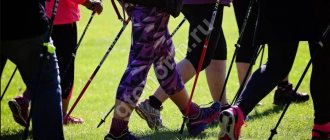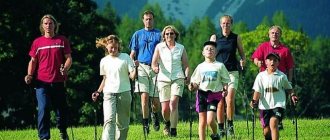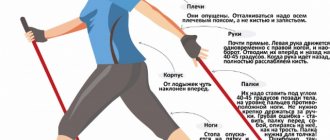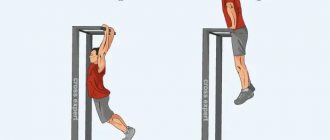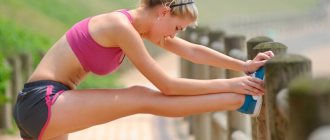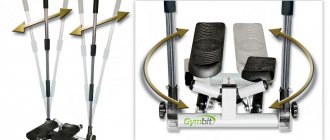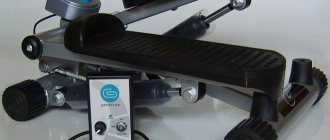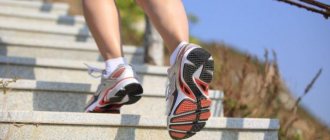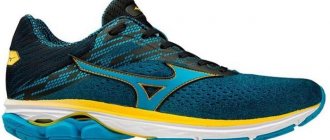Scandinavian (Nordic, Nordic) walking is a type of amateur sport. It looks like this: a person walks, leaning on special poles, a little like ski poles. Nordic walking is not a stereotypical walk for the elderly, but an independent sports activity for people of any age and activity level.
This young sport appeared thanks to Finnish skiers who practiced walking with ski poles in the summer as a preparation for the season. In winter, these athletes showed better results in skiing competitions. The activity gradually became widespread - special tracks appeared, and the geography expanded to other countries in Scandinavia and Northern Europe. In 1997, Nordic walking with poles received a patent thanks to the Finnish athlete Marco Kantaneva. He realized his idea - a sport for people of any age and training, in the open air, strengthening the heart, muscles and including stretching. Marco has improved the design of poles, developed a set of exercises and has been promoting the activity for more than 20 years all over the world - not only in South America and Central Africa.
Scientists from different countries conducted clinical studies on the health-improving potential of the new activity, which greatly promoted Nordic walking. Main conclusions:
- Nordic walking strengthens the muscles of the back and shoulder girdle, which is superior to, for example, running - it does not involve the upper half of the body. Along with the development of the muscles of the upper body, the volume of the lungs also increases - by more than 30% compared to a regular walk.
- Uses 90% of the body's muscles, while a walking step uses only 70%.
- Burns 1.5 times more energy than normal walking.
- Nordic walking with poles does not cause impact, unlike running. For people prone to obesity, it is useful as a therapeutic sport, at the same time more intense and active than regular walking, and at the same time safe for the joints.
- Relying on poles reduces the load not only on the knees and pelvis, but also on the heel bones. Nordic walking is an assistant for diseases of the joints of the lower extremities, such as gout, heel spurs and others.
- Improves posture, balance and coordination of movements.
This sport is indicated for a variety of diseases. Firstly, Nordic walking is a mandatory rehabilitation component after injuries and operations of the musculoskeletal system.
Secondly, it is recommended for the following list of conditions:
- scoliosis;
- chronic pain of the neck, back, shoulders;
- bronchial asthma and other pulmonary diseases;
- Parkinson's disease;
- neuroses, depression;
- insomnia;
- overweight.
As a preventive measure, Nordic walking will be useful for atherosclerosis and arterial hypertension.
There are no contraindications as such. Except, of course, for acute conditions and prescribed bed rest. Physician approval is also required for serious cardiac conditions.
Nordic walking technique
The Nordic walking technique is positioned as natural, so it is not difficult to learn. The foot is first placed on the heel and then moves to the toe. The arms and legs move freely and synchronously: the left hand together with the left leg, the right hand together with the right. The arm that goes forward is bent at the elbow, the other is held at the level of the pelvis.
The step width is normal, the movements are smooth, without jerking. The pace is a little higher than a walking pace. To increase intensity, you need to increase the amplitude of your arm swing.
Training
After warming up, you can proceed directly to walking. It is better to choose a quiet street for this, or even better, a park. So, let's start our health walk:
- Secure the loops of the poles to your arms, lower your limbs and begin to move forward slowly. “Nordics” are not used in this case. Concentrate on walking relaxed, with your shoulders relaxed and your arms slightly swaying back and forth;
- Continue moving, slightly holding the poles and swinging them in time with your movements (but still do not use “Nordic” moves). Lengthen your steps by stepping on your heel first and “rolling” your foot onto your toes. At this time, push off slightly from your knee;
- Now you can use the sticks. Try to get into a rhythm (left arm - right leg and vice versa) and concentrate on keeping the Nordics parallel to each other and your elbow joint bent at the correct angle;
- Keep the poles close to your body. During movement, the pelvis should rise quite high, and the body should lean forward slightly. At the same time, make sure that your back is completely straight.
The intensity of your workouts should be adjusted based on how you feel. If you want to increase the load, then simply push off the surface with your Nordics harder, lengthen your steps or increase the length of the poles.
Where to begin?
The golden rule of any workout is to start with a warm-up. 10-12 minutes are enough to warm up your muscles and joints. Pay attention to your entire body, starting from your neck to the tips of your feet - this will protect you from the risk of sprains that happen “in cold weather” and prepare your heart for stress.
Before training, also be sure to check the condition of the fastenings and adjust the length of the straps holding the poles in your hands.
Norwegian walking, technique and exercise variations
Nordic walking, the instructions for which have a lot of variations, is based on several main points, each of which has its own personal execution technique. The main points consist of:
- Diagonal type walks . This type is the most primitive to study, since it only requires synchronous work of the lower and upper extremities. The diagonal type of Nordic walking assumes an average speed of 5 km/h on flat terrain, while the technique is as similar as possible to a standard ski step;
- Asymmetrical walking . This type will require increased hand work, since when you move one leg forward, you must extend and fix both hands with sticks, pushing with them. This technique will allow you to maintain a fairly high speed of 7-8 km/h, but you should not move at this pace for longer than 30 minutes, followed by a break. Great for burning calories and for people with problems with leg joints;
- "Stick runs" . A similar exercise with asymmetrical walking, with only one difference, “stick jogging” will require you to move at an increased pace, which is equivalent to an easy jog. This variation perfectly trains endurance and reduces excess weight, but it is best to use “stick runs” for short distances, alternating them with diagonal walking.
These three variations of Norwegian walking are the basic and most effective examples, suitable for virtually all categories of the population of any country. However, despite this, you should take into account a general set of rules, the implementation of which will allow you to get the maximum benefit from walking of this type, and virtually completely eliminate the risk of even minimal injuries.
The basic rules are points such as:
- Nordic walking poles must be purchased exclusively in specialized stores and have an unsurpassed strength resource, since it is these devices that will bear the main load when practicing Nordic walking;
- You should keep in mind that the Internet has a lot of information about what Norwegian walking poles are, how to choose a particular set of poles, their length and what can replace them. However, from all the information provided, only one conclusion should be drawn: Norwegian walking poles can only be replaced with ski poles. All other variations are categorically unacceptable, as they can not only contribute to your injuries, but also cause harm to the ligaments and joints of your hands!
- You can practice Nordic walking on almost any terrain, except rocky slopes and mountains.
How often to exercise?
Trainers recommend that beginners start with walking for 15 minutes 2 times a week. Compare it with your preparedness and condition, do not bring yourself to exhaustion. But it shouldn’t be too easy: let the load be felt so that the heart and muscles are trained. Increase the pace gradually, focusing on the sensations, or ask the instructor to help create a training regimen.
Many lovers note that daily walks add a boost of vigor and joy if you devote at least an hour to them.
What's the use of this?
The main benefits of Nordic walking are as follows:
- It has a great effect on the condition of the heart and blood vessels;
- very useful for the spine, improves posture;
- normalizes blood pressure;
- improves coordination of movements;
- increases muscle tone;
- activates blood circulation;
- increases the body's endurance;
- makes immunity stronger;
- relieves muscle spasms;
- accelerates recovery after injuries, surgeries, heart problems;
- helps with stress and nervous feelings;
- calories are wasted, which is important for losing weight;
- Suitable for old, young, everyone;
- and most importantly, it lifts your spirits and gives you joy in life!
Read about the additional benefits of such walking here.
The main thing is to walk correctly, follow the instructions, and do a light warm-up before starting classes. And then the consequences of this will be the most pleasant.
Hitch
At the end of the workout, the muscles are warmed up - and this is the right time to stretch. Do some stretching exercises for your back, shoulders, hips, and calves. It is important to slow down, go into relaxation mode and switch your heart from an elevated heart rate to a normal one.
After the first workouts, it is useful to visit the sauna: the procedure will help slow down the synthesis of lactic acid - the muscles will hurt less, the metabolism will speed up, and relaxation will occur.
During training, you can combine slow and fast segments, wide and small steps, combine walking with short runs, physical exercise and even breaks.
How to choose Nordic walking poles
Nordic walking is impossible without the main accessory: poles. Without them, it loses a major benefit as it is important to engage the shoulders and core.
Ski poles will not work: they are much longer than Scandinavian ones. Among the popular ski sizes, it is very difficult to choose suitable ones. For example, for a height of 160 cm, a length of 110 cm is suitable - and this is a children’s ski size. Walking poles also have a graphite tip that does not wear off on the asphalt. The tips are round, so they are less likely to get stuck in uneven roads, such as paving stones. The kit usually includes rubber plugs that reduce the knocking and grinding of sticks.
Poles for trekking and cross-country running are also not suitable:
- For trekking, a simple strap on the handle is enough - which can be easily removed from the hand in case of a dangerous situation. To walk, you need a lanyard in the form of a half-glove - your hand will always be in it. This will properly distribute the effort and relieve the stress on the joints.
- The shaft of a proper walking pole is thinner and lighter than a trekking pole, which gives the correct balance of movements without adding extra weight.
- The anti-shock system, which is found on trekking poles, is prohibited from being installed on Nordic walking poles by the international association of this sport INWA. It can injure the elbow joint or pinch the thoracic spine when trying to rotate the shoulder.
- A lanyard made of genuine leather, a mount for an avalanche probe or camera, quick adjustment are redundant options that are not very popular in the city and significantly add to the price.
Do you need a warm-up?
Do we need to warm up before getting out of our chairs and walking to the kitchen? Now you have answered the question.
Of course, warm-up movements will never be superfluous. It is always useful to stretch your joints and stretch stiff muscles. Let's put it this way: let it not be a warm-up, but some kind of addition to Nordic walking in the form of exercises. Because standing in the middle of the forest and doing such “exercises” is very useful.
Without fail, this type of activity does not require any preliminary exercises. Of course, if you are planning to run with poles, then you really need to warm up, just like before sprinting.
In the case of a regular walk or workout for weight loss, it will be useful to vary the speed of your steps. It is best to start small, gradually accelerating to 5-7 km per hour or alternating intervals of fast and slow movements.
At first you need to walk slowly, slightly raising the poles with each step. We don’t make any special efforts to support ourselves. After 2-3 minutes we speed up and raise the poles higher. After 10 minutes, you can move your arms to full range. This will be the optimal warm-up.
It is better to do exercises in the middle of walking or after it. We took the sticks, put them together and did squats (a comfortable number of times), body turns, waved our legs, arms, you can even practice fencing (just don’t kill anyone, there are quite sharp metal teeth at the ends of the sticks).
Thus, warming up before Nordic walking is walking itself.
Types of poles suitable for Nordic walking
Let's see what design features are important to take into account and what materials are optimal for comfortable use in an urban environment.
Monolithic, telescopic and folding
The shaft can be folding: from several parts that are held by a cord inside, telescopic (sliding from two or three sections) and solid.
Solid poles are considered the most durable due to their simplicity of design, safe - they cannot unexpectedly fold or break, and durable.
Telescopic ones allow you to adjust the length, which can be useful if the poles are used by several people in turn. Another option is quick adjustment to changing terrain, which is not very relevant for Nordic walking. Sliding poles are fragile at the joints, they can become unusable when sand and water get there, and freeze in winter.
Folding (sectional) ones are presented mainly in the high price segment and are suitable for those who plan to take them on trips - they will fit in both a suitcase and a hiking backpack.
If you travel often and plan to walk everywhere with poles, then consider the possibility of folding or shortening the poles - it is important that they are compact. If poles will always be waiting for you at home, take a closer look at solid models. Fixed length poles are a great option for a beginner.
Aluminum and carbon
The shaft of Nordic walking poles is made of aluminum alloy, carbon fiber (carbon fiber) or composites containing carbon and fiberglass.
Carbon fiber is strong, lightweight and so elastic that it springs back on its own.
Telescopic poles of budget models are made of aluminum alloys . There are folding models with a composite carbon shaft, but they are quite expensive.
An important characteristic of composite carbon Nordic walking poles is the carbon index, which reflects the percentage of carbon fiber content. For beginners, carbon poles with an index of 20% to 30% are optimal. Walking poles with a lower carbon fiber content will be unreliable, while those with a higher carbon fiber content will be too stiff.
Contraindications
The list of contraindications to Nordic walking is short:
- pressure above 180/100 mm. rt. Art.;
- arrhythmia, severe cardiac/respiratory failure;
- angina at rest and unstable form of the disease (heart pain and shortness of breath occur with minimal exertion);
- infections accompanied by fever;
- chronic pathologies in the acute stage;
- conditions requiring emergency surgical care.
If a person is able to move at least a little without assistance, he can practice Nordic walking. The main thing is to choose the right mode (tempo) and duration of training. Qualified fitness instructors at the Igora resort will help you with this.
What details should I pay attention to?
Let's disassemble the Scandinavian sticks into “parts” to choose the appropriate option. We have already talked about the type of shaft - folding, sectional and monolithic, now we will pay attention to other important details.
Lanyard
Lanyard - a fastening for fixing a hand to a stick, similar to a fingerless glove. It’s good when the lanyard is quick-release – it’s convenient to answer an incoming call or take a good photo. But during the main training period, he should hold his palm well.
Tips
Each Nordic walking pole has a spike at the end. It is made of a very durable material - tungsten carbide. This spike is also called a “claw” - it can be freely stuck into the soil or sand, and it will neither slip nor get stuck.
The best Nordic walking poles have a set of removable spikes that are used for various surfaces (snow, ice, soil).
“Claws” are not suitable for walking on asphalt, so the kit includes special “boots” - removable rubber tips.
Rubber tips wear out quite quickly, so, regardless of the price of the poles, you should get a set of spare ones.
Universal technique
This is Nordic walking for beginners! This method of healing now attracts millions of people in different countries. In fact, this is a special type of walking with sticks. It looks a little strange, but it is safe, effective and very useful.
Gradually it is becoming popular here too. No one is shocked anymore by people marching through parks and streets with sticks at any time of the year.
Who even came up with this, you ask. The history of this sport is very interesting! Thus, shepherds in ancient times walked with the help of sticks. But the basics of the technique, in its current form, were developed by Marco Cantaneve.
He is a Finnish skier and developed everything in the early 90s. I prescribed all the movements step by step and started advertising my invention. Initially, its goal was to give skiers the opportunity to train in the summer when there is no snow.
Check list
- Pay attention to the manufacturer. Well-known and customer-tested global brands: Exel, Ergoforce, Leki, RealStick, Marcom Gabel, Kartu, Kompardell, Swix.
- Make sure that the tip is removable - even the most durable one will eventually wear off, and without it the poles will be unusable. If the kit does not include replacement tips, immediately buy additional ones.
- Choose rubber rather than plastic tips.
- Inspect the product visually and with your hands. When “trying on”, weigh the stick in your hands, inspect the shaft, try to fold and adjust the stick (if it is not solid).
- The lanyard should fit snugly to the hand and be comfortable to the touch. Do not buy poles with plastic handles - your hands will slip on them because the material does not wick away or absorb moisture.
- Discounted walking poles are more likely to break.
- Check the poles in action - do they vibrate too much when walking? Refuse if the vibration is unpleasant and the handles do not dampen this sensation.
- The warranty period must be at least 2 years.
Harm
Nordic walking with poles brings many benefits. Everyone talks about this, everyone firmly believes that the activity is absolutely safe. In principle, this is true. As always, there are a few “buts”.
And this is immoderate human enthusiasm, which can drive the heart even with such a harmless activity. If you walk too hard with poles, you can hurt yourself. In addition, if you dress incorrectly, you can sweat and catch a cold. You can also slip, break a stick, or get scratched on a piece of it.
In general, there are many risks. But they are all determined by a conscious factor, since Nordic walking with poles has no contraindications, in the medical sense, as such. Of course, you should not give physical activity to people with serious heart or musculoskeletal diseases.
To minimize risks, we do the following:
- We choose sticks wisely.
- We choose clothes and shoes - everything should be comfortable and reliable. It makes sense to spend money on one pair of good sneakers; you can’t skimp on this. High-quality shoes will absorb movement, fit comfortably on your feet, and will last you at least 5 years. In other words, one pair of good shoes is better than several pairs of bad ones.
- We pay attention to our well-being. If you feel weak, have a cold, are injured or are overtired, it is better to stay at home and recover. Older people with heart disease or who have had a heart attack should walk slowly and gradually increase the duration of their walks.
- Contrary to the previous point, you should not cancel walks because of a bad mood or household chores. Your health comes first. Let’s not forget the benefits of Nordic walking with poles and head to the park!
How to choose the size of Nordic walking poles?
For monolithic poles, the formula is as follows: multiply your own height by a factor of 0.68, round the resulting result to a multiple of 5. For example, if your height is 172 cm, multiply 172 by 0.68 = 116.96. We round the result to 120 cm - this is the appropriate length of the stick.
Telescopic models have a range of lengths, the main thing is to hit it with the result.
Since the length of arms, legs and torso varies from person to person, the size needed varies. Additionally, check the stick this way: place the tip on the toe of your foot - the elbow of the hand holding the stick should bend at a right angle.
How to dress and put on shoes for Nordic walking?
For outdoor activities, comfortable sportswear that does not restrict movement is suitable, for example, a tracksuit or a set of T-shirts and shorts/pants/tights. Choose synthetic materials - they have more effective thermoregulation compared to natural ones. When wet, they do not become heavy and dry quickly, remove excess heat and remain comfortable in hot conditions. In cool weather, it is worth insulating yourself with several layers of clothing: sports underwear, a T-shirt/thermal jacket/fleece (for warm spring/autumn chilly weather/winter), a windbreaker or a light sports jacket on top.
On your feet - regular training sneakers. The main thing is that they fit properly, do not rub, and the sole is flexible.
Will Nordic walking with poles help you lose weight?
- According to research, Nordic walking really helps burn fat. During training, more muscle groups are involved than during normal walking or running. One active session is equal to 2 hours of quiet walking (burns about 300-400 calories per hour).
- To lose weight, devote at least 1 hour to training 5 times a week - this is the optimal regime without exhaustion. Of course, an integrated approach with a review of diet, stress and sleep will enhance the effect.
- Sports tone up such difficult areas to work on as the riding breeches area and the back of the arms.
- Walking over rough terrain with an increase in height will be even more effective - when moving on snow, loose stones, gravel, sand, and also uphill, more calories are consumed and stabilizer muscles work, helping to maintain balance.
To increase the load, use special weights for poles or try on a backpack with a load of 10-15 kg. Another way to pump up your muscles stronger: increase the length of the shaft by 5-10 cm.
Nordic walking is popular in large cities - Moscow, St. Petersburg, Rostov-on-Don, Irkutsk, Perm, Tyumen, Anapa, Sochi and others. And in the regions it is actively gaining sympathy - representative offices of clubs are opening that conduct introductory training and introduce everyone to the activity. It has a low barrier to entry - no expensive special equipment or technical skills are needed, and the sports community is very friendly. You can make new friends in almost any city park. Not only within the city, but also while traveling, walks will become more interesting and active if you take Scandinavian walking sticks with you. This is an affordable, simple and useful sport that improves health, improves body quality, appearance, lifts your spirits, and puts you in the mood for communication with nature and pleasant people.
The instructor says: Nordic walking is twice as effective as running, it works 90% of the muscles
More about training, nutrition, sports medicine and sports as an activity - in the “Health” section
Subscribe to the Sports.ru telegram channel about health
Photo: unsplash.com/Markus Spiske, Joppe Spaa, lucas Favre; East News/plysiukvv, juriskraulis; RIA Novosti/Igor Onuchin; globallookpress.com/Daniel Karmann/dpa
Benefit
There is a lot of talk about Nordic walking today. Some go with ski poles, some take 2 canes, and some buy exclusively expensive equipment from leading brands. Later I will tell you which poles are better, and how to choose them in general.
So, what are the benefits of Nordic walking:
- Improved blood circulation.
- Shoulder girdle training
- Prevention of osteochondrosis: strengthening muscles, reducing the load on the spine.
- The possibility of long walking increases all its beneficial properties many times over, compared to running. But on the contrary, there are fewer negative factors.
- Nordic walking for pensioners is one of the few sports that they can safely practice without risk to health.
- Doing Nordic walking is good for the respiratory system - it has been proven that the lungs are trained and ventilated. And this ensures the prevention of respiratory infections.
- A corollary from the previous point is blood oxygen saturation. O2 molecules will be delivered to every cell of the body. A 40-60 minute walk at an average pace is enough.
- Rehabilitation benefits have been proven (and are widely used today). Nordic walking is used as rehabilitation after fractures of the hip, knees, and lower legs. People walk with poles as additional support - which provides better stability and reduces the load on the healing bones.
Read also
- Can walking be considered a sport? Does it help you lose weight? How many kilometers a day should you walk?
- How much do tennis lessons cost? How much will it cost to rent a court and use a coach? How to choose a racket?
- What is canicross? What dog breeds are best for competitions? What do you need to get started?
- What is crossfit: history of origin and who is this sport suitable for?
- The benefits of swimming - what strengthens swimming in the pool and what muscles work, how many calories are burned from swimming
- The benefits of cycling - losing weight and developing muscle strength
- Workout: what is it and how to start doing it? What exercises are suitable for a beginner?
- Zorbing: what kind of entertainment is it, who is it suitable for and how to prepare for it
- Windsurfing for beginners - answers to questions about riding a board with a sail
- Bungee or bungee jumping. Is it sport or entertainment? How is it different from rope jumping?
